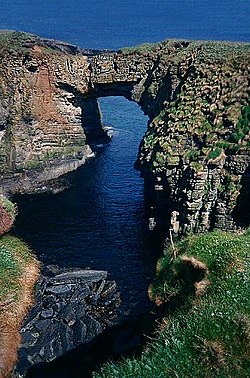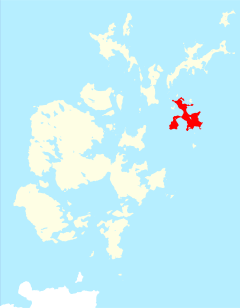Stronsay: Difference between revisions
mNo edit summary |
mNo edit summary |
||
| Line 4: | Line 4: | ||
|picture=PicVat.jpg | |picture=PicVat.jpg | ||
|picture caption=Vat of Kirbister, on the east coast of Stronsay | |picture caption=Vat of Kirbister, on the east coast of Stronsay | ||
|map= | |map=Stronsay Orkney.svg | ||
|os grid ref=HY669239 | |os grid ref=HY669239 | ||
|area=12½ square miles | |area=12½ square miles | ||
Latest revision as of 07:55, 1 September 2012
| Stronsay | |
 Vat of Kirbister, on the east coast of Stronsay | |
|---|---|
| Main village: | Whitehall |
| Location | |
| Grid reference: | HY669239 |
| Area: | 12½ square miles |
| Data | |
| Population: | 343 |
Stronsay is an island in Orkney. The main village is Whitehall, home to a heritage centre. It is 12½ square miles in size, and reaches no more than 144 feet at its highest point.
The island's name is from Old Norse, and means either "Good Fishing Island" or "Good Farming Island".
Sights on the island include the Vat of Kirbister natural arch and seabirds including arctic terns.
Ferries sail from Whitehall to Kirkwall on Mainland, Orkney, and aeroplanes fly there from the island's airstrip.
There is one school on the island which is for both Primary and Secondary pupils. There is a Church of Scotland kirk and two Roman Catholic chapels.
History
Prehistory
Two flint arrowheads discovered at a site investigated by Orkney College in April 2007 are believed to date from the late Paleolithic or early Mesolithic periods some 10-12,000 years ago. They were found amongst a scattered collection of other tools on a farm. If confirmed they could be the earliest human artefacts found so far in North Britain.[1]
18th and 19th centuries
The island is now agricultural, but during the 18th and 19th centuries, kelp collection and herring curing employed up to five thousand people. The population while still high for a remote island, was over a thousand for the entire 19th century, and up until the mid 20th century. The 1891 census, for example, recorded a population of 1275 people, excluding seasonal itinerants involved in the herring industry. [2]
The kelp burning industry thrived in the 18th century, and some of the ruins of kilns can still be seen. It was started by James Fea of Whitehall in 1727,[2] and lasted into the early 19th century.
The Stronsay beast was a mysterious, decomposing corpse of a sea-creature that was stranded in 1808. The carcass measured 55 feet in length, with the "neck" 15 feet and the circumference of the body 10 feet.[3] The corpse created a great stir, with some proclaiming it a sea serpent, but others have claimed it was a decayed basking shark.
Geography and geology
Like nearly all of Orkney, Stronsay is made up of old red sandstone which has produced a fine soil in many places.[2] It is generally low lying.
With an area of 12½ square miles, Stronsey is the seventh largest of the Orkney islands. Surrounding small islands include Linga Holm, Papa Stronsay, the Holm of Huip (named after a district in north west Stronsay) and the Holms of Spurness. To the north is Sanday, to the north west Eday, Shapinsay and Mainland Orkney to the south west, and Auskerry due south.
Wildlife

While the landscape is treeless, the fertile soil supports a wide variety of wild flowers including oysterplant, frog orchids, adder's tongue, and also a naturalised population of Patagonian ragwort.[2]
There are a wide variety of birds on the island, and birdwatchers have recorded many rarities here. The common birds include Whooper Swan, various ducks and geese including the Greater White-fronted Goose, as well as Common Redshank, Common Snipe, Common Quail, Great Skua, Corn Bunting and Corncrake.
The more unusual occasional visitors which have been recorded include:
- American Golden Plover
- Arctic Redpoll
- Pied Wheatear
- Rustic Bunting
- Scarlet Rosefinch
- Tawny Pipit
- Various warblers including: Radde's Warbler, Marsh Warbler and Subalpine Warbler[2]
References
- ↑ Ross, John (5 October 2007) "Orkney arrowheads find points to Scotland's earliest settlement". Edinburgh. The Scotsman.
- ↑ 2.0 2.1 2.2 2.3 2.4 Haswell-Smith, Hamish (2004). The Scottish Islands. Edinburgh: Canongate. ISBN 1841954543.
- ↑ Newton, Michael (2005). Stronsay Beast. McFarland & Company, Inc.. pp. 442–443. ISBN 0-7864-2036-7.
| Islands of Orkney |
|---|
|
Inhabited islands: |
